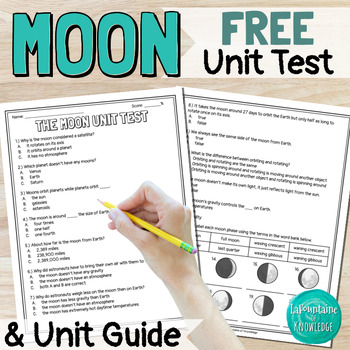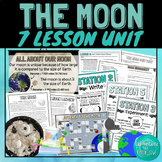The Moon, Moon Phases, Lunar Cycle End of Unit Test Assessment and Unit Guide
- PDF
Also included in
- This moon unit bundle includes 7 one hour lesson plans with all of the resources needed to implement them in your science classroom. This unit covers moons as natural satellites, orbit vs. rotation, facts about the moon (size, distance from Earth, lack of atmosphere, temperatures, gravity, etc.), thPrice $16.10Original Price $23.00Save $6.90
Description
This FREE 20 question science test all about the moon covers moons as natural satellites, facts about our moon (size, distance from earth, lack of atmosphere, temperatures, gravity, orbit and rotation, etc.), and the lunar cycle including the 8 moon phases (new moon, waxing crescent, first quarter, waxing gibbous, full moon, waning gibbous, last quarter, waning crescent). It also includes an answer key.
Note: This free resource is part of a 7 lesson moon unit. Feel free to use the assessment on its own, or purchase the unit bundle to access all of the resources included in the lesson plans at 30% off!
Please follow my store here for more great resources!
You can also find me on Facebook, Instagram, and lafountaineofknowledge.com where you'll discover ideas, inspiration, and plenty of freebies! Or join my email list to get my monthly newsletter with exclusive FREE resources you can't get anywhere else!
Want free money to spend on Teachers Pay Teachers? Rate this product to earn some TpT credit! Leaving feedback helps us both out and takes less than a minute! Your support makes it possible for me to continue making and sharing great resources! Thank you!






